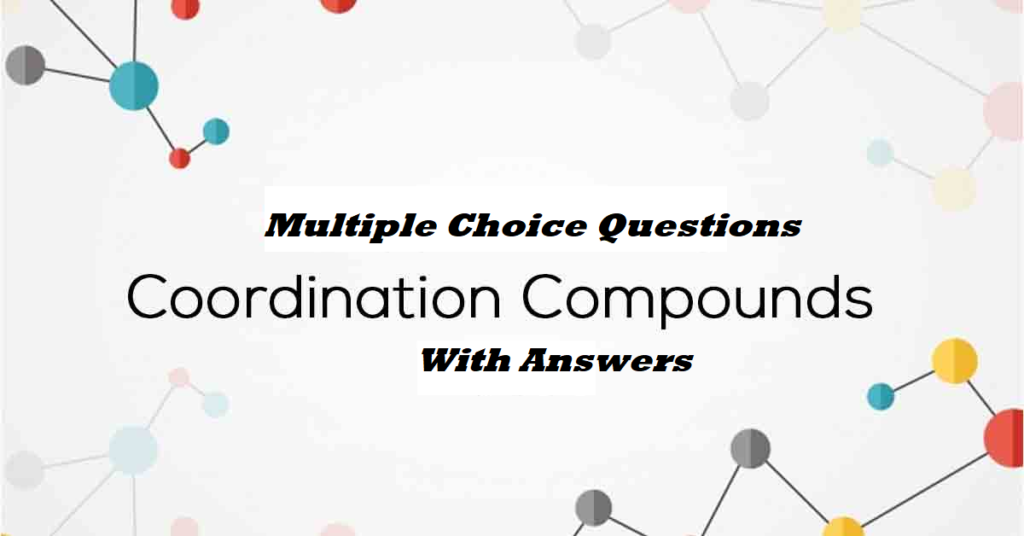Multiple Choice Questions Coordination Compounds
Coordination compounds are molecules that possess one or multiple metal centers that is bound to ligands (atoms, ions, or molecules that donate electrons to the metal). These complexes can be neutral or charged. In order to test your knowledge solve Multiple Choice Questions Coordination Compounds.
1. Which of the following compounds formed by Cu2+ ions is most stable?
(a) Cu2+ + 4NH3 → [Cu(NH3)4]2+; Log K = 11.6
(b) Cu2+ + 4CN– → [Cu(CN)4]2–; Log K = 27.3
(c) Cu2+ + 2 en → [Cu(en)2]2+; Log K = 15.4
(d) Cu2+ + 4H2O → [Cu(H2O)4]2+; Log K = 8.9
2. The colour of the coordination compounds depends on the crystals’ field splitting. What will be the correct order of absorption of the wavelength of light in the visible region? for the complexes [CO(NH3)6 ]3+; [CO(CN)6 ]3–; [CO(H2O)6]3+.
(a) [CO (CN)6]3– > [CO(NH3)6]3+ > [CO(H2O)6]3+
(b) [CO (NH3)6]3+ > [CO(H2O)6]3+ > [CO(CN)6]3–
(c) [CO (H2O)6]3+ > [CO(NH3)6]3+ > [CO(CN)6]3–
(d) [CO (CN)6]3– > [CO(NH3)6]3+ > [CO(H2O)6]3+
3. When 1 mol COCl3 (NH3)5 is treated with an excess of AgNO3; 0.2 mol of AgCl is obtained. The conductivity of solution will correspond to.
(a) 1:3 electrolyte
(b) 1 : 2 electrolyte
(c) 1 : 1 electrolyte
(d) 3 : 1 electrolyte
4. The correct IUPAC name of [Pt(NH3)2 Cl2] is
(a) Diamminedichloridoplatinum (II)
(b) Diamminedichlorideplatinum (IV)
(c) Diamminedichlorideplatinum (0)
(d) Dimminedichlorideplatinum (IV)
5. This stabilization of coordination compounds due to chelation is called the chelate effect. Which of the following is the most stable complex species?
(a) [Fe (CO)5 ] (b) [Fe(CN)6 ]3–
(c) [Fe(C2O4)3]3+ (d) [Fe(H2O)6 ]3+
Multiple Choice Questions Coordination Compounds
6. Indicate the complexion which shows geometrical isomerism
(a) [Cr(H2O)4Cl2]+ (b) [Pt(NH3)3Cl]
(c) [Pt(NH3)6]3+ (d) [CO(CN)5(NC)]3-
7. The CFSE for octahedral [CaCl6]4– is 18,000 cm–1. The CFSE for tetrahedral [COCl6]2– will be:
(a) 18,000 cm–1 (b) 16,000 cm–1
(c) 8,000 cm–1 (d) 20,000 cm–1
8. Due to the presence of ambidentate ligands coordination compounds show isomerism. Palladium complexes of the type [Pd(C6H5)2(SCN)2] and [Pd(C6H5)2(NCS)2] are:
(a) Linkage isomers. (b) Coordination isomers
(c) Ionisation isomers (d) Geometrical isomers
9. The compounds [CO(SO4)(NH3)5 Br and [CO(SO4) (NH3)5] Cl
(a) Linkage isomerism (b) Ionisation isomerism
(c) Coordination isomerism (d) No isomerism
10. Which of the following species is not impacted to be a ligand?
(a) NO (b) NH4+
(c) NH2CH2NH2 (d) CO
Multiple Choice Questions Coordination Compounds
11. What kind of isomerism exists between [Cr (H2O)6] Cl3 (violet) and [Cr(H2O)5Cl]Cl2.H2O (greyish-green)?
(a) Linkage isomerism (b) Solvate isomerism
(c) Ionisation isomerism (d) Coordination isomerism
12. IUPAC name of [Pt(NH3)2Cl(NO2)] is:
(a) Platinum diaminechloridonitrite
(b) Chloronitrito-N-ammine platinum(II)
(c) Diamminechloridonitrite-N-platinum (II)
(d) Diamminechlornitrite-N-platinate(II)
13. Atomic numbers of Mn, Fe, and Co are 25, 26, and 27 respectively. Which of the following inner orbital octahedral complexions is diamagnetic?
(a) [CO(NH3)6]3+ (b) [Mn(CN)6]3–
(c) [Fe(CN)6]4– (d) [Fe(CN)6]3–
14. Which of the following options are correct for [Fe(CN)6]3– complex?
(a) d2sp3 hybridisation (b) sp3d2 hybridisation
(c) paramagnetic (d) diamagnetic
15. Identify the optically active compounds from the following:
(a) [CO(en)3]3+
(b) trans [CO(en)2Cl2]+
(c) Cis [CO[en)2Cl2]+
(d) [Cr(NH3)5Cl]
Multiple Choice Questions Coordination Compounds
16. Match the complexions given in column 1 with the hybridization and number of unpaired electrons given in column 2 and assign the correct
Column 1 Column 2
(A) [Cr(H2O)6]3+ (1) dsp2; 1
(B) [CO(CN)4]2– (2) sp3d2; 5
(C) [Ni(NH3)6]2+ (3) d2sp3; 3
(D) [MnF6]4– (4) sp3; 4
(5) sp3d2; 2
(a) A–3, B–1, C–5, D–2 (b) A–4, B–3, C–2, D–1
(c) A–3, B–2, C–4, D–1 (d) A–4, B–1, C–2, D–3
17. Match the complex species given in column 1 with the possible isomerism given in column 1 and assign the correct code:
| Column 1 | Column 2 | |
| (A) [CO(NCS) (NH3)5] (SO3) | (1) | + 4 |
| (B) [CO(NH3)4 Cl2] SO4 | (2) | 0 |
| (C) [CO (S2O3)3] Na4 | (3) | + 1 |
| (D) [CO2(CO)8] | (4) | + 2 |
| (5) | + 3 | |
| (a) A–1, B–2, C–4, D–5 | (b) | A–4, B–3, C–2, D–1 |
| (c) A–5, B–1, C–4, D–2 | (d) | A–4, B–2, C–2, D–3 |
Note: In the following questions a statement of assertion followed by a statement of reason is given. Choose the correct answer out of the following choice.
(a) Both assertion and reason are true, and the reason is the correct explanation of the assertion.
(b) Both assertion and reason are true, but the reason is not the correct explanation of the assertion.
(c) The assertion is true, but the reason is
(d) Both assertion and reason are false.
18. Assertion: Toxic metal ions are removed by the chelating
Reason: Chelate complexes tend to be move stable.
19. Assertion: [(Fe(CN)6]3– ion shows a magnetic moment corresponding to two unpaired electrons.
Reason: Because it has d2sp3 type hybridization.
ANSWERS:
1. (b) 2. (c) 3. (b) 4. (a) 5. (c) 6. (a) 7. (c)
8. (a) 9. (d) 10. (b) 11. (b) 12. (c) 13. (a, c)
14. (a, c) 15. (a, c) 16. (b) 17. (d) 18. (a) 19. (d)



